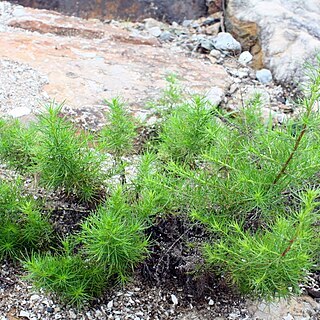Herbs annual, to 1 m tall. Stem erect, much branched above, light green, stout, ribbed; branches ascending or oblique, long, slender. Leaves gray-green, filiform-linear, slightly upcurved, semiterete, usually 1.5-5 × ca. 0.15 cm, glabrous, base contracted, apex subacute. Glomerules mostly inserted near base of leaves, 1-5-flowered. Flowers bisexual or sometimes some female. Perianth yellow-green, cupular, 1-1.5 mm (in bisexual flowers) or gray-green, subglobose, ca. 0.7 mm in diam., fleshy (in female flowers); segments ovate-triangular, enlarged in fruit, becoming black when dry, and together star-shaped, apex obtuse. Stamens 5; anthers obovate to oblong, ca. 0.9 mm. Stigmas 2, black-brown, slightly recurved. Utricle enclosed in perianth; pericarp membranous. Seed horizontal or oblique, black, sublustrous, lenticular, ca. 2 mm in diam., distinctly granular pitted, rim margin obtuse or acute; perisperm scant. Fl. and fr. Jul-Sep.
More
An annual herb. It grows up to 1 m tall. The stems are light green and they have slight furrows along them. The branches are slender. The leaves do not have leaf stalks. They are succulent and narrow and cylinder shaped. They are greyish-green. They are 2-5 cm long by 1-5 mm thick. They become smaller upward. The flowers occur as 2-5 in the axils. The fruit is a round but flattened pouch 2 mm across.
It is a temperate climate plant. It grows on saline-alkaline soils of beaches, wastelands, canal banks, field margins. It grows in wetlands.
More
Saline meadows, solonchaks, sandy and pebbly seashores, refuse dumps and waste ground.

